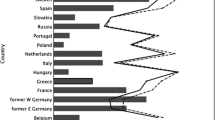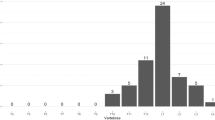Summary
□Background: In population-based studies non-participation rates of about one third of the sample can be expected. The number of refusals may even be higher, if personal attendence of the subjects is requested. A different participation behaviour of the diseased and non-diseased may affect the prevalence estimation of a disease as well as the risk factor association.
□Methods and Results: The European Vertebral Osteoporosis Study (EVOS) is an international, multicenter, cross-sectional survey in men and women aged 50 to 79 years. Within Europe 36 centres recruited 17 342 participants. The 8 German centres contribute about one fourth of the data. In Germany subjects were recruited in several steps: random sample drawing from population registries, initial postal questionnaire, medical interview, lateral X-rays of the thoracic and lumbar spine. Depending on the extent of participation a variable amount of sociodemographic data and information on subjective health is available from the non-reachable, non-responders, and responders with incomplete and with complete examination. A comparison of the different participation groups showed, that especially old women were lost from the study. Compared to those, who only answered to an initial questionaire, subjects, who were interviewed and X-rayed, more often suffered from back pain but reported a better functional capacity. This could be a hint on a selection of a population of the “worried well”.
□Conclusions: On the whole the selection processes seem to have a minor influence on the outcome. The initial postal questionnaire turned out to be effective in collecting basic information from those who refused to attend a personal examination.
Similar content being viewed by others
Literatur
Beard CM, Lane AW, O’Fallon WM, Riggs BL, Melton LJ III. Comparison of respondents and nonrespondents in an osteoporosis study. Annals Epidemiol 1994;4:398–403.
Criqui MH, Barret-Connor E, Austin M. Differences between respondents and nonrespondents in a population-based cardiovascular disease study. Am J Epidemiol 1978;108:367–72.
Criqui MH. Response bias and risk ratios in epidemiologic studies. Am J Epidemiol 1979; 109:394–9.
Heilbrunn LK, Ross PD, Wasnich RD, Yano K, Vogel JM. Characteristics of respondents and nonrespondents in a prospective study of osteoporosis. J Clin Epidemiol 1991;44: 233–9.
Kohlmann T, Deck R, Raspe H. Prävalenz und Schweregrad von Rückenschmerzen in der Lübecker Bevölkerung. Akt Rheumatol 1995;20:99–104.
Kohlmann T, Raspe H. Der Funktionsfragebogen Hannover zur alltagsnahen Diagnostik der Funktionsbeeinträchtigung durch Rückenschmerzen (FFbH-R). Rehabilitation 1996;35:I-VIII.
Kleinbaum DG, Morgenstern H, Kupper LL. Selection bias in epidemiologic studies. Am J Epidemiol 1981;113:452–63.
Matthis C, Weber U, O’Neill TW, Raspe H, and the European Vertebral Osteoporosis Study (EVOS) Group. Health impact associated with vertebral deformities — results from the European Vertebral Osteoporosis Study (EVOS). Osteoporosis Int. submitted.
McCloskey EV, Spector TD, Eyres KS et al. The assessment of vertebral deformitiy: a method for use in population studies and clinical trials. Osteoporosis Int 1993;3:138–47.
O’Neill TW, Marsden D, Silman AJ, and the European Vertebral Osteoporosis Study Group. Differences in the characteristics of responders and non-responders in a prevalence survey of osteoporosis. Osteoporosis Int 1995;5:327–34.
O’Neill TW, Marsden D, Matthis C, Raspe H, Silman AJ, and the European Vertebral Osteoporosis Study Group. Survey response rates: national and regional differences in a European multicentre study of vertebral osteoporosis. J Epidemiol Community Health 1995; 49:87–93.
O’Neill TW, Felsenberg D, Varlow J, et al. The prevalence of vertebral deformity in European men and women: the European Vertebral Osteoporosis Study. J Bone Miner Res 1996; 11:1010–8.
O’Neill TW. Osteoporosis Int 1996; 6:262.letter.
Silman AJ, and the European Vertebral Osteoporosis Study Group. The European Vertebral Osteoporosis Study (EVOS). In Christiansen C, Riis B, eds. Osteoporosis. Proceedings 1993. Fourth international symposium on osteoporosis and consensus development conference. Osteopress, Rodovre (Denmark) 1993:65–6.
Author information
Authors and Affiliations
Rights and permissions
About this article
Cite this article
Matthis, C., Schlaich, C., Scheidt-Nave, C. et al. Die europäische Studie zur vertebralen Osteoporose (EVOS): Teilnahmebereitschaft und Selektionsverzerrung in Deutschland. Med Klin 93 (Suppl 2), 18–25 (1998). https://doi.org/10.1007/BF03041994
Issue Date:
DOI: https://doi.org/10.1007/BF03041994




